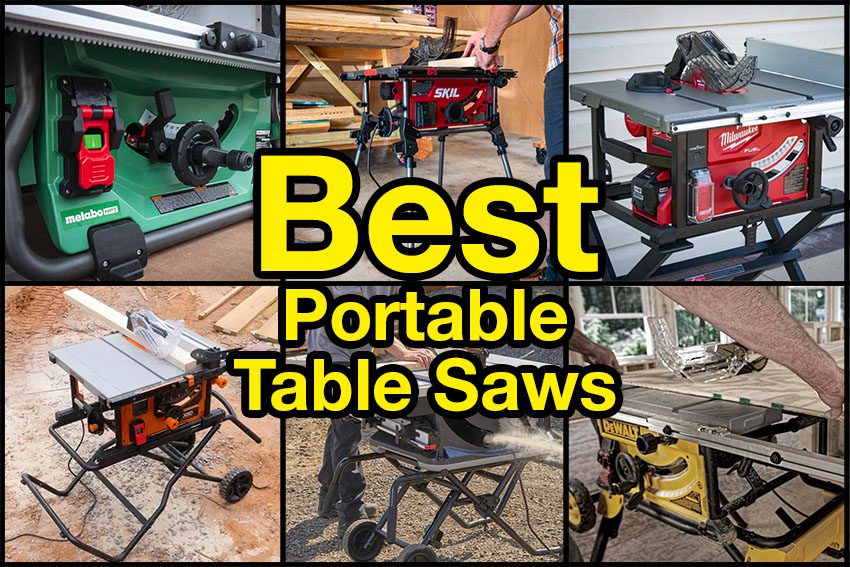When most people think “table saw”, they’re referring to portable models. Nearly every major brand makes at least one, so what makes the best portable jobsite table saw stand out from the pack?
Quite a bit, actually. From power sources to high-tech safety features and plenty of innovation in between, there’s a lot a variation to consider. In this roundup, I’ll walk you through my top picks to help you narrow down the competition.
Looking for another saw… a bigger saw? Check out our Best Table Saw main page.
Our Top Picks for the Best Portable Jobsite Table Saw
- Best Overall: Flex 24V Hybrid Cordless 10-Inch Table Saw
Jump to this Saw↓ - Best Corded: DeWalt 10-Inch Table Saw DWE7491
Jump to this Saw ↓ - Best Cordless: Metabo HPT 36V MultiVolt 10-Inch Table Saw
Jump to this Saw ↓ - Best for Safety: SawStop Jobsite Saw Pro Table Saw
Jump to this Saw ↓ - Best Value: Ridgid 10-Inch Table Saw with Rolling Stand
Jump to this Saw ↓ - Best for DIYers: Skil 10-Inch Table Saw with Integrated Stand
Jump to this Saw ↓
New to buying table saws? Jump to the Buying Guide section and learn what to look for!
Best Portable Jobsite Table Saw Overall
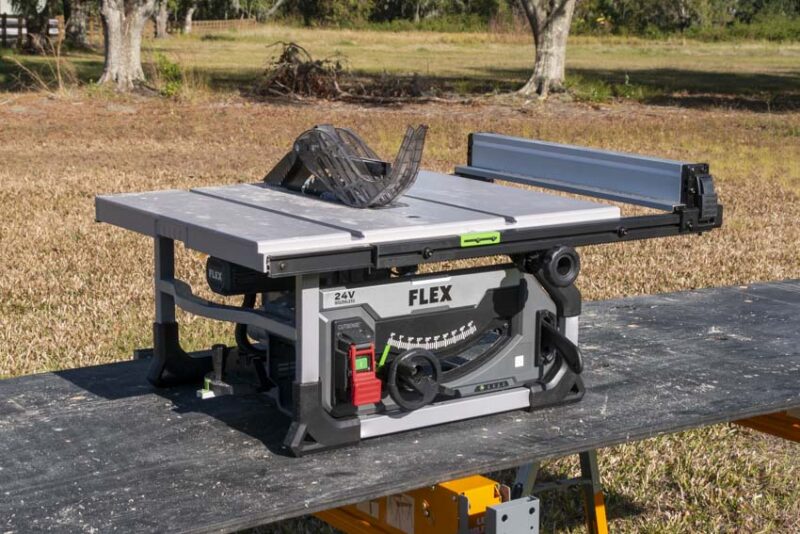
Flex Hybrid 10-inch Table Saw FX7221-1J
- 10-inch blade
- 5500 RPM
- 3 1/2-inch+ cutting depth
- 13/16-inch dado capacity
- 30.5-inch rip capacity
Reasons to Buy
- Well-thought-out design
- Unique features other saws don’t have
- Corded or cordless operation
- Strong performance
- Accurate cutting
Reasons to Consider Another Model
- You want a more compact model
- You’re on a smaller budget
- Battery power doesn’t interest you
- You want flesh detection
Standout Features
- Hybrid battery or AC power supply
- CutSense automatic blade stop
- Cuts 4x in a single pass
- LED lights on the fence
- Rack-and-pinion fence system
- Lifetime warranty with registration by 12/31/24
Flex’s built their flagship model around the best table saw features other competitors use and added unique elements we hadn’t seen before. Combined with performance doesn’t compromise when using a battery for power, Flex stands out from its competition and earns our respect as the top overall model.
Price: $549.99 bare, $749.99 kit with a 10Ah Stacked Lithium battery
Best Corded Portable Jobsite Table Saw
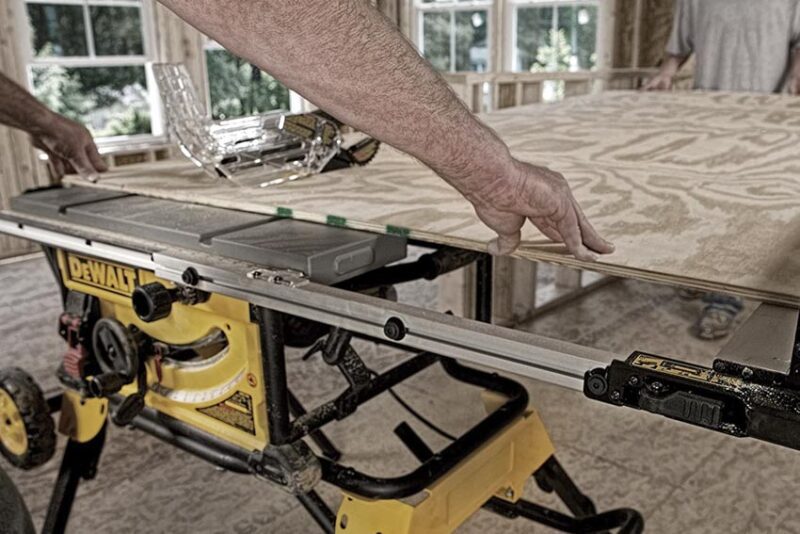
DeWalt 10-Inch Table Saw DWE7491
- 10-inch blade
- 4800 RPM
- 3 1/8-inch cutting depth
- 13/16-inch dado capacity
- 32.5-inch rip capacity
Reasons to Buy
- Excellent design
- Strong performance
- Accurate cutting
Reasons to Consider Another Model
- You want a more compact model
- You’re on a smaller budget
- You want battery power as an option
- You want flesh detection
- You’d prefer a gravity-rise stand
Standout Features
- Generous rip capacity
- Rack-and-pinion fence system
DeWalt’s DWE741 is the design that set the standard for many of today’s most recent models, including the best cordless and hybrid portable table saws. While there’s not much that really stands out aside from the large rip capacity, there’s not much to complain about, either. This saw has everything you need with nothing you don’t, making it one of the most popular picks for Pros.
Price: $649 with stand
Pro Tip: Note that table saws often have additional shipping charges due to their size and weight. If you’re ordering online, many retailers will ship to your local store for free.
Best Cordless Portable Jobsite Table Saw
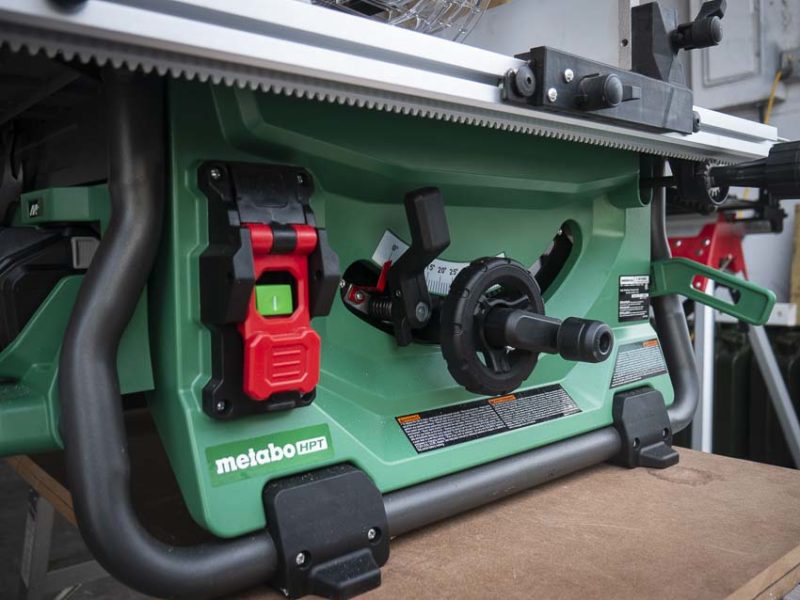
Metabo HPT Hybrid 10-Inch Table Saw C3610DRJQ4M
- 10-inch blade
- 5000 RPM
- 3 1/8-inch cutting depth
- 13/16-inch dado capacity
- 35-inch rip capacity
Reasons to Buy
- Corded or cordless operation
- Smooth, stable performance
- Accurate cutting
- Top-ranked material support
Reasons to Consider Another Model
- You want a more compact model
- You’re on a smaller budget
- Battery power doesn’t interest you
- You want flesh detection
- No spare blade storage
- You want a stand included in the package
Standout Features
- Hybrid battery or AC power supply
- Outstanding 35-inch rip capacity
- Outfeed support bar included
- Rack-and-pinion fence system
While Flex’s hybrid design is our top choice overall, Metabo HPT is close on its heels as another solid hybrid option. Flex has stronger performance and unique features, but not even our corded saws have the material support Metabo HPT does. With a generous 35-inch rip capacity and included outfeed support, it’s a compelling option if you’re frequently cutting without a helper.
Price: $599 bare tool
Best Portable Jobsite Table Saw for Safety
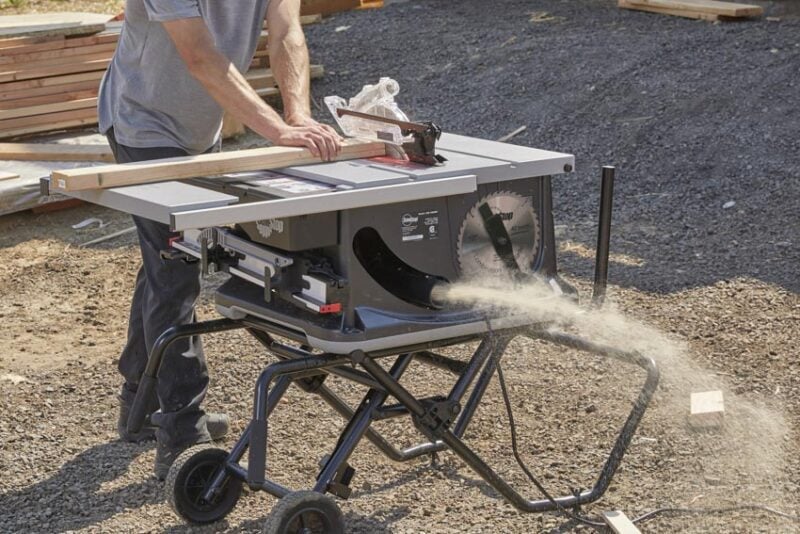
SawStop Jobsite Saw Pro JSS-120A60
- 10-inch blade
- 4000 RPM
- 3 1/8-inch cutting depth
- 13/16-inch dado capacity
- 25.5-inch rip capacity
Reasons to Buy
- Flesh detection safety system
- Excellent performance
- Accurate cutting
- Easier to use than other models
Reasons to Consider Another Model
- You want a more compact model
- You’re on a smaller budget
- You want battery power as an option
- You don’t want flesh detection
Standout Features
- Blade drops and stops immediately on contact with skin
- Self-aligning T-style fence
- One-turn blade raising/lowering
- Micro bevel adjustment dial
- Internal storage drawer
- Rack-and-pinion fence system
There’s a ton to be said for having all your fingers at the end of the day and SawStop has the only saw that ensures it. The design team didn’t rest its laurels on that alone, though, and included thoughtful design improvements in accuracy, ease of use, and storage. Even without the safety technology, this model would still be in strong consideration as the best corded portable jobsite table saw.
Price: $1,599 with stand
Best Portable Jobsite Table Saw Value
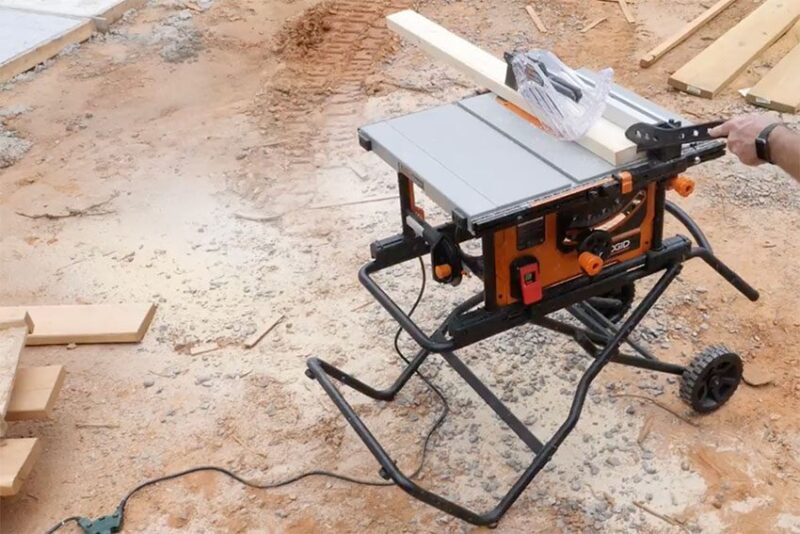
Ridgid 10-Inch Table Saw R4550
- 10-inch blade
- 5000 RPM
- 3 1/2-inch cutting depth
- 5/8-inch dado capacity
- 32.5-inch rip capacity
Reasons to Buy
- Less expensive than other models
Reasons to Consider Another Model
- You want a more compact model
- You’d prefer an upgraded build
- You want battery power as an option
- You want flesh detection
Standout Features
- Generous rip capacity
- Rack-and-pinion fence system
Even though it doesn’t have a ton of bells and whistles, Ridgid’s R4550 checks off the right boxes with a build and design that favor value-minded Pros. At $529, you get better quality and stability that many of the lower-priced saws struggle with and it includes a wheeled gravity-rise stand.
Price: $529 with stand
Best Budget Portable Jobsite Table Saw for DIYers
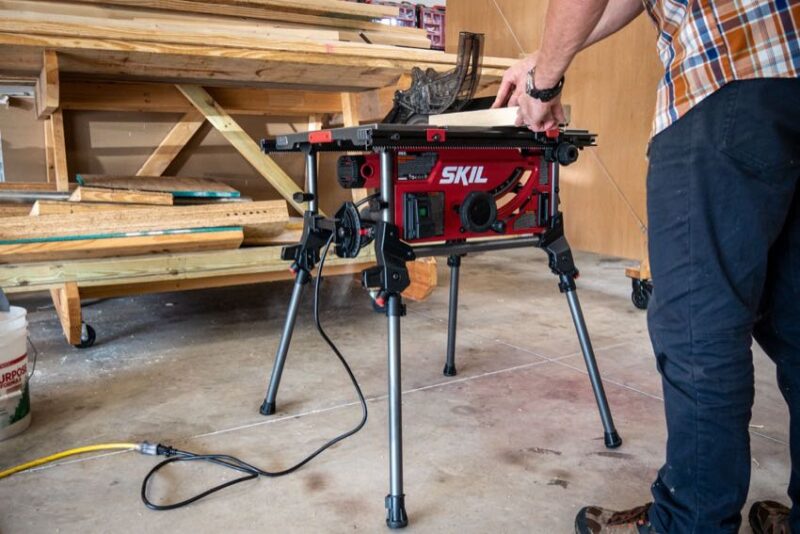
Skil 10-Inch Table Saw TS6307-00
- 10-inch blade
- 4500 RPM
- 3 1/2-inch cutting depth
- 5/8-inch dado capacity
- 25.5-inch rip capacity
Reasons to Buy
- Excellent value
- Compact design has a smaller storage footprint
Reasons to Consider Another Model
- You’d prefer a Pro-grade build
- You want battery power as an option
- You want flesh detection
- You’d like a stand with wheels
Standout Features
- Integrated stand
- Rack-and-pinion fence system
Skil’s 10-inch table saw is what I recommend for DIYers who don’t want to step up to Pro-level pricing. It’s a capable saw that offers a smaller storage footprint than most saw/stand combos at a price that’s tough to beat. Side-by-side against other budget-friendly options, Skil stands out with better overall quality and more confident performance.
Price: $299.00
Best Portable Jobsite Table Saws From Other Brands We Trust
Bosch GTS15-10 10-Inch Table Saw
Upgrades Bosch’s popular 4100XC with a rack-and-pinion fence system, larger table with ClampZone, blade brake, and the blade capacity to cut 4x lumber in one pass.
Price: $649 with stand
Festool CSC SYS 50 EBI Cordless Table Saw
This super-compact battery-powered table saw is purpose-built for high-quality interior work.
Price: $1,499 – $1,999
Milwaukee 2736 M18 Fuel 8 1/4-Inch Cordless Table Saw
Reliable cordless table saw with One-Key connectivity that operates on the massive M18 Fuel battery system.
Price: $449 bare tool, $599 kit with a 12.0Ah High Output battery and charger
Ryobi PBLTS01K 18V One + HP Brushless 8 1/4-Inch Cordless Table Saw
This is the best cordless option we’ve seen for serious DIYers who want cord-free convenience combined with a compact size.
Price: $339 bare, $399 kit with two 4.0Ah High Performance batteries and charger
Skilsaw SPT99-11 10-Inch Heavy Duty Worm Drive Table Saw
Using a true worm drive gearing system, this table saw has the strongest cutting performance we tested wrapped into a well-thought-out design.
Price: $649 with stand
Best Portable Jobsite Table Saw Buying Guide
Shopping Tips
- Buying a table saw online may include additional shipping charges. Look for free shipping or ship-to-store options to save some money.
- Rolling stands typically require assembly. Plan to spend 30 minutes to a couple of hours for assembly depending on how experienced you are.
- If you need a stand, you’ll save money and have easier pairing by getting a saw/stand combo.
How Much Power Do You Need?
Even though you might be ripping sheet goods primarily, you may come across times when you need to rip 2x or 4x material. While most portable table saws are great on thin sheets, other lumber separates them in terms of power.
A 15-amp motor is an absolute must in our book. From there, it’s all about dialing in that power so there’s plenty of torque to back up the blade speed. Don’t let big RPM numbers do all the talking—we’d rather give up a few hundred RPMs for a design with more torque than have the motor bog down when we’re cutting hardwoods.
What Size Blade and Table Should You Get?
It might seem odd to talk about blade and table size together, but there’s a relationship between the two that often comes down to recent safety regulations.
The two main table saw blade sizes are 8 1/4-inch and 10-inch. The larger blade diameter has a larger cut capacity, sometimes enough to cut 4x lumber in one pass (but not always).
8 1/4-inch blades typically max around 2 1/2 inches, so either size has more than enough capacity to cut 2x lumber.
Aside from the blade diameters, check the dado capacity if you’re planning to make those cuts for joinery.
The big thing to keep in mind is that the 8 1/4-inch models typically have smaller tables, and we want at least 24 inches to cover 1/2-sheet rip cuts in plywood. Those smaller saws can still have 15-amp motors with plenty of strength, though. So, before you reject an 8 1/4-inch table saw, check to see if its table and dado capacity meet your needs.
What Blade Tooth Count Should You Use?
The higher the tooth count, the finer the finish a blade leaves on your cuts. Most table saws come with either a 24-tooth or 40-tooth blade, and those are fine for framing and rough cut projects.
If you want to minimize sanding and want the least amount of post-cutting work to do, step up to a 60-tooth or 80-tooth blade. For the most serious woodworking projects, you can go even higher.
Just keep in mind that higher tooth counts require more muscle from the saw, so you need to feed material slower than you do with low tooth count blades.
How Can You Maximize Accuracy?
For the best accuracy on a table saw, don’t buy a portable one! Cabinet table saws are much better suited for ultimate precision when 1/16th of an inch makes a huge difference in your results.
Still, high accuracy is something you should expect from your portable table saw. Most of this happens along the fence. We try to avoid fences that are easy to lock down out of square when possible. Models with clamps on both sides tend to fall into that category.
Single-clamp fences typically do a nice job of self-squaring when you lock it down. Just be sure that it’s beefy enough not to push to the side when you start feeding material.
One of the easiest fences to use that’s also highly accurate is the rack-and-pinion style. The first one we used was on DeWalt’s popular DWE7491 and many brands have come on board with similar designs. In our opinion, it’s the way to go.
Should You Worry About Dust Collection?
If you’re primarily using your portable table saw outside, dust collection may not be a big priority. If you’re using it in a shop or indoors, it’s a different story. Most models do a fine job of collecting sawdust and there’s not much variance in the chute designs. Just pay attention to the diameter so you have the right hose or adapter and be sure to use a high-CFM shop vacuum for the best results.
Do You Need Flesh Detection Safety Features?
All table saws sold in the U.S. come with a riving knife, anti-kickback pawls, and a split blade guard. Because some cuts can’t be made with these safety features installed, they are removable and you can use the saw without them. Cutting without those devices is more dangerous, so avoid it if you can.
The best safety technology is the flesh detection pioneered by SawStop. Bosch’s Reaxx also had a version, but it’s no longer available in the US. That said, there’s no denying how effective SawStop’s technology is at preventing catastrophic injuries.
If it’s in your budget, go ahead and pull the trigger. The first time it saves you a trip to the ER, it’ll pay for itself and then some. After all, table saw injuries are still one of the most common tool-related injuries, and most people I know prefer keeping all ten fingers.
There are trade-offs, though. SawStop table saws are significantly more expensive. They also trash your blade and require a replacement brake when it activates. It’s still a lot better and less expensive than a trip to the ER, though.
What’s the Best Stand for a Portable Table Saw?
Stability and portability are two key areas that affect one another. As you’re shopping, something that’s lightweight can seem appealing. That might make portability very easy, but it can sacrifice stability. The last thing you want is the saw to move as you feed material.
No matter what type of stand you want, look for solid materials that offer little to no wobble in the working position and adjustable feet to help level the saw on uneven ground.
A gravity-rise design tends to be the best portable table saw stand for most Pros and serious DIYers. These stands lift into a working position by simply hitting a foot release and pushing the handles down toward the ground.
This type of stand can also help with transportation thanks to onboard wheels. Large wheels can make rolling the saw over less-than-ideal ground, going up a flight of stairs, or moving from the garage into the driveway easier.
Why You Can Trust Pro Tool Reviews
Ever check out a “review” site and you can’t tell if they actually tested anything or if they’re just “recommending” the Amazon top sellers? That’s not us. We won’t recommend anything unless we’d use it ourselves, and we don’t care who the primary retailer is. It’s all about giving you a legitimate recommendation and our honest opinion of each product.
We’ve been in business since 2008 covering tools, writing reviews, and reporting on industry news in the construction and lawn care industries. Our Pro reviewers work in the trades and have the skills and experience to know whether tools can perform well in the field.
Each year, we bring in and review more than 350 individual products. Our team will put our hands on hundreds of additional tools at media events and trade shows throughout the year.
Pro Tool Reviews consults with innovators in the technology and design of tools to gain a broader grasp of where these products fit and how they work.
We work with more than two dozen professional contractors around the United States who review products for us on real job sites. We consult with them extensively on testing methods, categories, and practical applications.
Our site will provide more than 500 pieces of new content this year absolutely free for our readers. That includes objective evaluations of individual tools and products.
The end result is information you can trust because of the editorial, scientific, and real-world professional experience we collectively utilize each and every time we pick up and test a tool.

